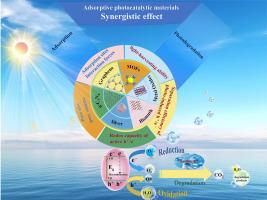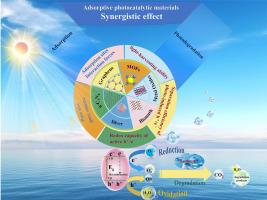用于降解抗生素的吸附型光催化材料的最新进展
IF 23.5
1区 化学
Q1 CHEMISTRY, INORGANIC & NUCLEAR
引用次数: 0
摘要
抗生素的滥用和水处理方法的不足导致了一些重大问题,包括耐药基因的出现,对人类健康和生态系统都构成了严重威胁。尽管废水中抗生素的含量微乎其微,但富集抗生素对于有效去除废水至关重要。因此,合成具有优异吸附特性的光催化剂成为关键因素。虽然以往的研究已广泛涉及抗生素的吸附或光催化分解,但目前还缺乏对擅长降解抗生素的吸附光催化剂的全面汇编。本研究探讨了主要抗生素类别及其基本特性,分析了溶液 pH 值对抗生素吸附的影响,概述了高级氧化过程(AOPs)中影响抗生素光催化降解的基本原理和关键因素。研究还简要介绍了涉及主要原子和官能团的吸附机理,包括静电、疏水、酸碱、π-π、阳离子-π相互作用、孔隙填充和氢键作用。此外,研究还总结了六种常见吸附性光催化材料的能带结构及其相应的抗生素降解主要机制,阐明了它们在抗生素吸附和光降解方面的应用。这些材料包括石墨氮化碳基、铋基、金属有机框架(MOFs)基、半导体金属氧化物基、银基、石墨烯基和其他光催化剂。此外,本文还阐明了提高这些复合材料的吸附性能和光催化功效的因素,强调了吸附和光催化之间的协同作用对提高效率的重要意义。最后,本文概括了光催化抗生素降解领域当前的关注点,并概述了未来的研究前景。它是一份宝贵的资料,为旨在清除水体中抗生素的研究提供了指导,为制作和合成高效光催化抗生素降解材料提供了不可或缺的理论见解。本文章由计算机程序翻译,如有差异,请以英文原文为准。


Recent advances in sorption-based photocatalytic materials for the degradation of antibiotics
The misuse of antibiotics and insufficient water treatment practices have resulted in significant issues, including the emergence of drug-resistant genes, posing grave threats to both human health and the ecosystem. Despite antibiotics being present in minute quantities within wastewater, their enrichment is crucial for effective removal. Thus, synthesizing photocatalysts with exceptional adsorption properties becomes pivotal factor. While previous studies have extensively covered the adsorption or photocatalytic breakdown of antibiotics, a comprehensive compilation of adsorption photocatalysts proficient in antibiotic degradation is lacking. This work explores major antibiotic classes and their fundamental properties, analyzes the impact of solution pH on antibiotic adsorption, and outlines the basic principles and key factors influencing the photocatalytic degradation of antibiotics in advanced oxidation processes (AOPs). It also briefly describes the adsorption mechanisms involving the main atoms and functional groups, including electrostatic, hydrophobic, acid-base, π-π, cation-π interactions, pore-filling, and hydrogen-bonding. Additionally, the study summarizes the energy band structures of six prevalent adsorptive photocatalytic materials and their corresponding primary mechanisms for antibiotic degradation, elucidating their applications in both antibiotic adsorption and photodegradation. These materials include graphitic carbon nitride-based, bismuth-based, metal-organic frameworks (MOFs)-based, semiconducting metal oxides-based, silver-based, graphene-based, and other photocatalysts. Moreover, it elucidates the factors augmenting adsorption performance and photocatalytic efficacy of these composite materials, underscoring the pivotal synergy between adsorption and photocatalysis for enhanced efficiency. Lastly, this paper encapsulates current concerns and outlines future research prospects in the realm of photocatalytic antibiotic degradation. It stands as a valuable resource, offering guidance for research aimed at purging antibiotics from water bodies, providing theoretical insights indispensable in crafting and synthesizing efficient photocatalytic materials for antibiotic degradation.
求助全文
通过发布文献求助,成功后即可免费获取论文全文。
去求助
来源期刊

Coordination Chemistry Reviews
化学-无机化学与核化学
CiteScore
34.30
自引率
5.30%
发文量
457
审稿时长
54 days
期刊介绍:
Coordination Chemistry Reviews offers rapid publication of review articles on current and significant topics in coordination chemistry, encompassing organometallic, supramolecular, theoretical, and bioinorganic chemistry. It also covers catalysis, materials chemistry, and metal-organic frameworks from a coordination chemistry perspective. Reviews summarize recent developments or discuss specific techniques, welcoming contributions from both established and emerging researchers.
The journal releases special issues on timely subjects, including those featuring contributions from specific regions or conferences. Occasional full-length book articles are also featured. Additionally, special volumes cover annual reviews of main group chemistry, transition metal group chemistry, and organometallic chemistry. These comprehensive reviews are vital resources for those engaged in coordination chemistry, further establishing Coordination Chemistry Reviews as a hub for insightful surveys in inorganic and physical inorganic chemistry.
 求助内容:
求助内容: 应助结果提醒方式:
应助结果提醒方式:


